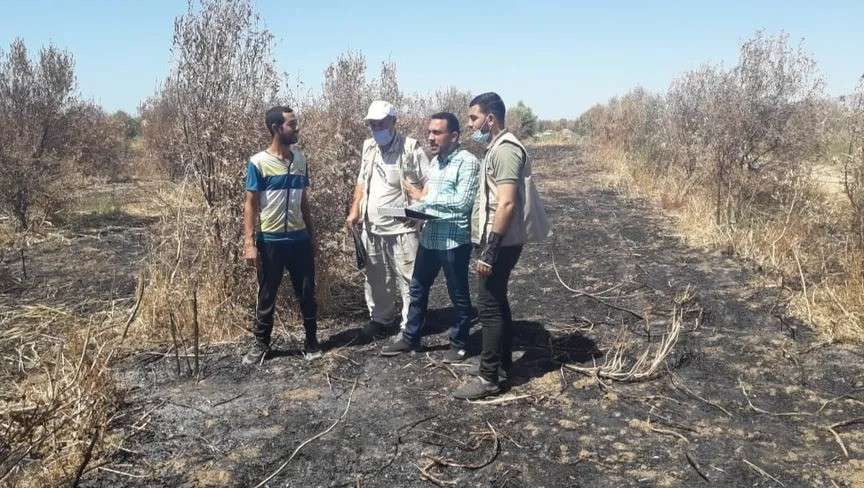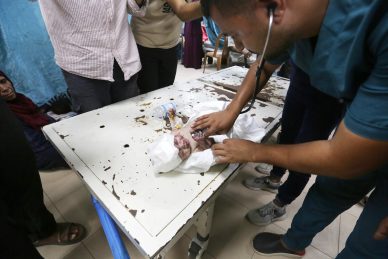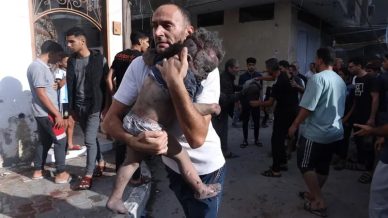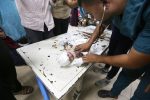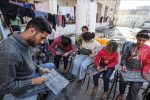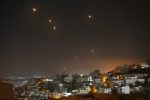GAZA, (PIC)
Farmer Um Muhammad Qadeeh has been working on the land for 30 years, inheriting agricultural practices from her nonagenarian father, who passed his expertise to all ten of his children, both male and female, all of whom work in agriculture.
Before the ongoing war on Gaza, the sixty-year-old started farming in greenhouses where she learned weeding, harvesting, and pruning processes farmers use to aerate trees and seedlings. She later learned to grow cucumbers and tomatoes.
Qadeeh owns 13 dunums, which have become unreachable following extensive Israeli army incursions into the eastern areas of Khan Yunis and which were razed along the security fence separating them from eastern Gaza.
Um Muhammad said that the land she owned was used to cultivate zucchini, spinach, tomatoes, and olives. She notes that she miraculously saved last year’s olive harvest as the ground invasion of the southern city had not yet begun. However, with the incursion into the city at the beginning of December 2023, she could no longer access the land, which was crushed by Israel’s military machinery, and any attempt to check on it felt like digging one’s own grave.
From the first moments of the war, the occupation army adopted a scorched earth policy, not only destroying residential buildings and public service facilities but also crushing more than 75% of Gaza’s agricultural land in its horrific war.
Figures reveal the catastrophe
Data from the Palestinian Central Bureau of Statistics regarding the impact of the war on the agricultural sector in Gaza for 2023 indicates that Khan Yunis has witnessed the destruction of more than 90% of its agricultural land, highlighting the immense damage inflicted on the agricultural infrastructure in the enclave, as the northern and central regions of Gaza have suffered the most during this war.
The bureau states that the central and northern areas of the Strip form the backbone of agriculture in Gaza, as the agricultural land in these areas collectively accounts for over 63% of the total agricultural area, providing the bulk of food for more than 2.3 million people living in the Strip.
Reports published by the Agricultural Work Committees estimate that the northern areas of Gaza are among the hardest hit by the war, controlling more than a third of the agricultural land in the Strip, with over 33% of the area designated for growing vegetables and field crops, contributing to over 30% of the Strip’s food needs from vegetables and field crops such as wheat and other grains.
Agriculture in Gaza serves as a lifeline for hundreds of thousands of its residents, who rely on it as a primary source of food and income, with around 55,000 workers estimated to be employed in the agricultural sector. It contributes about 11% to the gross domestic product, with exports of vegetables and horticultural products valued at over $32.8 million. Tomatoes and cucumbers represented 66% of these exports in 2022, according to the Palestinian Central Bureau of Statistics.
The bureau estimates the daily losses in agricultural production, including fishing and livestock sectors, at around $2 million, indicating direct losses of about $1 billion after a year of the genocidal war. The total loss value multiplies when accounting for the destruction of assets, agricultural properties, and the razing of agricultural areas.
Hunger as a weapon
The Agricultural Work Committees clarify that the damaged agricultural areas in Gaza are estimated at 117,000 dunums, providing 60,000 tons of vegetables and field crops. Gazans have been deprived of these food quantities by preventing farmers from accessing their lands for harvesting, in implementation of a decision by the Israeli War Minister to impose a blockade on the enclave and prevent its inhabitants from accessing essential resources, particularly food, aiming to starve and subdue them.
In this context, the Euro-Med Human Rights Monitor said that the Israeli occupation has rendered over 75% of the agricultural land in Gaza unusable, either by isolating it in preparation for annexation to the buffer zone in violation of international law or by systematically destroying and razing it, thereby institutionalizing famine in the Strip as a weapon of war, extending along the security fence in eastern Gaza and northward to a depth of almost 2 kilometers, covering an area estimated at about 96 km².
The Monitor explains that the remaining agricultural areas are very limited, mostly located in the Al Mawasi area west of Khan Yunis, which currently shelters hundreds of thousands of forcibly displaced individuals. The continuous Israeli military attacks have severe repercussions on public health, the environment, agricultural land, and the quality of water, soil, and air, with these effects interacting cumulatively, paving the way for alarming increases in mortality rates.
As the genocidal war on Gaza enters its second year, the Ministry of Agriculture in Gaza said that the occupation has targeted olive trees (with the harvest season starting at the end of October each year), which account for about 60% of the horticultural trees in the enclave. The percentage of land planted with horticultural trees is 30.9% of the total agricultural area in Gaza, with 31.3% in Khan Yunis Governorate and 22.3% in North Gaza Governorate, emphasizing the significant economic role of fruit-bearing trees, especially olive trees.
Regarding livestock production, Fouad Abu Saif from the Agricultural Work Committees said that the livestock sector in Gaza has suffered severe losses due to the war, as the poultry sector was completely destroyed, either due to direct bombardment or due to feed shortages and high consumption resulting from hunger. He pointed out that Gaza had achieved self-sufficiency in white meat and table eggs before the war.
A report from the Food and Agriculture Organization of the United Nations (FAO) in February 2024 indicates that the occupation army destroyed approximately 626 water wells, 47 water ponds, one port, 307 home animal shelters, 100 agricultural stores, 46 agricultural warehouses, 7 agricultural supply centers, 119 animal shelters, 11 rabbit farms, 26 dairy farms, 235 broiler chicken farms, 7 turkey farms, 203 sheep farms, 5 cattle farms, and 42 poultry and pigeon farms. Additionally, 339 greenhouses out of a total of 1,277 were destroyed, meaning that 26.6% of greenhouses were lost, indicating that the agricultural sector has entered a phase of collapse as the war continues.
The fishing sector in Gaza, which supports more than 4,054 fishermen, has also not escaped the impact of ongoing aggression. Abu Saif explains that the Gaza Strip produces about 4,600 tons of fish annually, according to reports from the Ministry of Agriculture in Gaza. However, this production has completely halted, and the fishing sector has faced total destruction, as it has been included among the primary targets of the occupation army.
Preliminary field reports indicate that the city of Gaza alone has witnessed the destruction of 98% of the fishing sector, including the Gaza port and more than 900 boats of various sizes due to direct bombardment. In Rafah and Deir al-Balah, more than 70% of the fishing sector has been destroyed, with over 600 boats lost.
Unprecedented situation
Regarding the current state of food security in Gaza and the damage inflicted on the agricultural food sector, Beth Beegle, Deputy Director-General of the Food and Agriculture Organization of the United Nations (FAO), states, “There are unprecedented levels of acute food insecurity, hunger, and famine-like conditions in Gaza. It is an unprecedented situation we find ourselves in. We have a measure for acute food insecurity called the Integrated Food Security Phase Classification.”
She explains that phases 3, 4, and 5 represent emergency, crisis, and disaster levels, respectively, and that “all 2.2 million residents of Gaza are now within these three categories.”
Even before the crisis worsened due to the war, nearly 60% of households in Gaza were experiencing or at risk of food insecurity, while 80% of the population relied on humanitarian assistance. The prohibition of using hunger as a weapon against civilians in wartime is a fundamental principle of international humanitarian law.
This prohibition is enshrined in several international legal documents, including the Additional Protocol II to the 1949 Geneva Conventions, which prohibits the use of hunger as a method of warfare against civilians. International humanitarian law emphasizes the protection of civilians and civilian property during armed conflict and specifically prohibits using hunger as a tool for pressure in conflicts, considering it a violation of international law.

